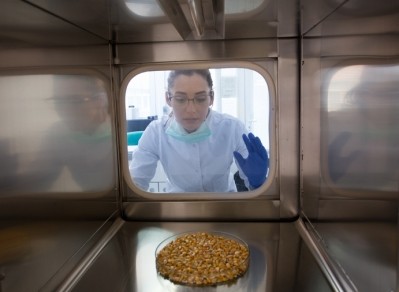Special Edition: IPPE Reports
Novus research seeks to improve phytase efficacy, improve ration formulation

We caught up with Frances Yan, senior research scientist in poultry nutrition at Novus International, at the International Production and Processing Expo (IPPE) in Atlanta to hear more about her work exploring the interaction of dietary phosphorus and calcium levels with phytase use in broiler diets.
Animal feeds are ideally formulated on an available basis, said Yan. However, that is not the system being used in regards to phosphorus in poultry now.
The current non-phytate phosphorus system sees limitations as some of the phytate-bound phosphorus is available to the animal and some of the added, non-bound phosphorus is not, she said. “We’re doing an approximation so we’re not that accurate,” she added.
Her ongoing research looks to better understand phosphorus digestibility and improve the efficiency for using phytase in a diet, she said. “Phytase is a cheaper way to provide phosphorus [in a diet] and so almost all producers are already using phytase, but are they using it to its maximum potential? Are they creating the right conditions?”
If phytase efficacy could be improved, then it would make feed less expensive as phosphorus is the third most expensive ingredient in the diet, she said. “We can optimize phosphorus nutrition and on the other side we can reduce phosphorus excretion, so, therefore we can reduce the environmental impact,” she added.
Improving the formulating system
In 2012, the Swine National Research Council adopted a digestible phosphorus approach as the basis of requirement determination and feed formulation, said Yan.
“They call it standardized total tract digestible phosphorus,” she said. “In the poultry community, we realized our system is not ideal, we’re not formulating based on available phosphorus, we’re formulating on approximation, there is a real interest for us to also switch to some sort of digestible basis.”
The most recent research is part of that ongoing project, she said.
“One of the biggest challenges is the digestibility values reported for specific ingredients in poultry are very variable,” she said. “It works out very well in swine, but in poultry if you look at the two ingredients that have been studied the most – corn and soybean meal – we look at the digestibility ranges, somewhere around 20-90% – we can’t use that number.”
Previously, digestibility studies focused on use of one specific ingredient in the diet, like corn or soybean meal, said Yan. In the current project, the researchers looked at a blended diet with both ingredients.
“Instead of looking at corn or soy, we tried to look at a corn-soy blend so we don’t have to add a lot of synthetic ingredients to try and see if we could get some numbers that make biological sense,” she said. “This is our first trial in this area.”
In the trial, five different corn and soybean meal-based diets were designed to offer differing levels of non-phytate Phosphorus (nPP) and calcium (Ca), and with or without 500 u/kg phytase, the researchers said. The varying levels included normal – 0.45 and 0.93%, marginal P and normal Ca – 0.3 and 0.93%, marginal phosphorus (P) and Ca – 0.3 and 0.78%, deficient P and normal Ca – 0.13 and 0.93%, and deficient P and marginal Ca – 0.13 and 0.78%.
Diets were given to 800 birds from days 17 to 22 of production, they said. Birds were harvested on day 22 to collected digesta and determine ileal P and Ca digestibility.
The project was able to provide digestibility information that made sense, said Yan. “The phosphorus digestibility in the absence of phytase was around 34%, so we were getting numbers that make sense,” she added.
“In the past, when we looked at organic phosphate they are supposed to be very unavailable and we sometimes got really high digestibility values like 80 or 90%,” she said. “And, when we looked at inorganic, they’re supposed to be highly available, because they’re not bound to a phytate molecule, and sometimes we got really low values.”
However, in the study, the values found suggested that the efficacy of the phytase was dependant on the levels of dietary calcium and phosphorus, she said. “Basically, the phytase works better if we have a marginal calcium level or we have very deficient phosphorus level so the phytase efficacy depends on certain factors,” she added.
“If the calcium is adequate and the phosphorus is very deficient, the digestibility was increased somewhere from 34% to 54%, so 20% improvement, but when the phosphorus is marginally deficient, then the improvement was lower instead of 20%, we saw 10% percent improvement, so it goes to 44%,” she said. “And if the calcium is also marginal, then the improvement was around 51% regardless of dietary phosphorus level.”
Part of the result may stem from the potential of calcium to bond with phytate, which reduces the phytase’s ability to break down phytate to release phosphorus into the diet, said Yan. However, the diet still has to include enough calcium to meet an animal’s requirements.
Phytase may work more efficiently when the phosphorus level is low, possibly because of the nature of a chemical reaction rate as affected by product concentration, she said. “The phytase is supposed to work on phytate and to release the phosphorus, so if we have the phosphorus already with a relatively high concentration, the phytase probably has to work harder,” she added.












